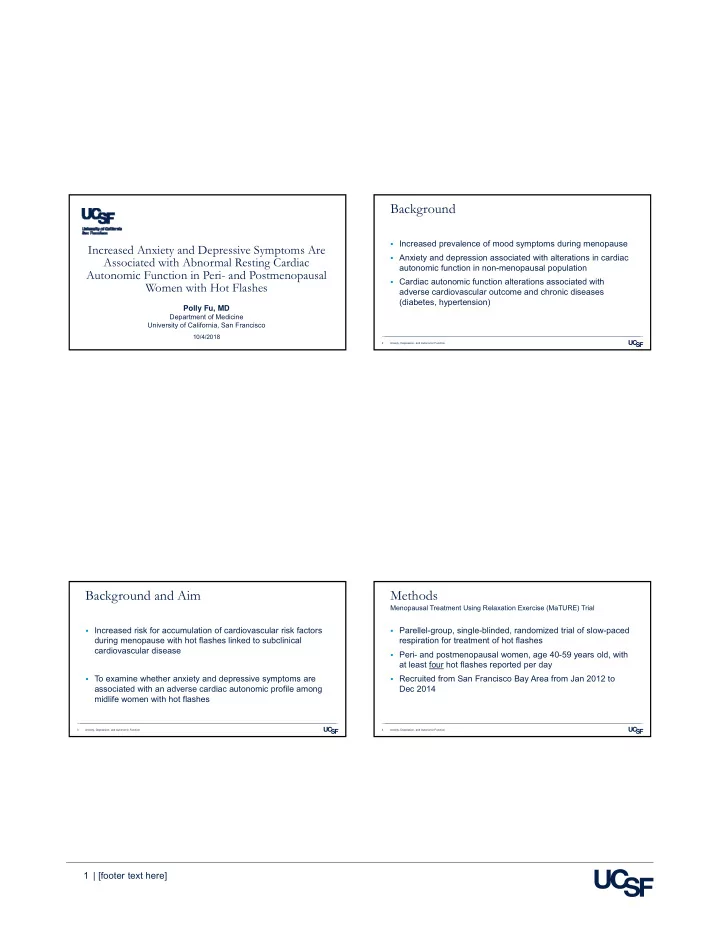

Background Increased prevalence of mood symptoms during menopause Increased Anxiety and Depressive Symptoms Are Anxiety and depression associated with alterations in cardiac Associated with Abnormal Resting Cardiac autonomic function in non-menopausal population Autonomic Function in Peri- and Postmenopausal Cardiac autonomic function alterations associated with Women with Hot Flashes adverse cardiovascular outcome and chronic diseases (diabetes, hypertension) Polly Fu, MD Department of Medicine University of California, San Francisco 10/4/2018 2 Anxiety, Depression, and Autonomic Function Background and Aim Methods Menopausal Treatment Using Relaxation Exercise (MaTURE) Trial Increased risk for accumulation of cardiovascular risk factors Parellel-group, single-blinded, randomized trial of slow-paced during menopause with hot flashes linked to subclinical respiration for treatment of hot flashes cardiovascular disease Peri- and postmenopausal women, age 40-59 years old, with at least four hot flashes reported per day To examine whether anxiety and depressive symptoms are Recruited from San Francisco Bay Area from Jan 2012 to associated with an adverse cardiac autonomic profile among Dec 2014 midlife women with hot flashes 3 Anxiety, Depression, and Autonomic Function 4 Anxiety, Depression, and Autonomic Function 1 | [footer text here]
Methods Methods Menopausal Treatment Using Relaxation Exercise (MaTURE) Trial Menopausal Treatment Using Relaxation Exercise (MaTURE) Trial Anxiety and depressive symptoms assessed as continuous Resting cardiac autonomic function assessed via impedence scores cardiography and ECG - Spielberger State Trait Anxiety Inventory - Respiratory sinus arrhythmia (RSA): Parasympathetic activity - Hospital Anxiety and Depression Scale - Pre-ejection period (PEP): Sympathetic activity - Beck Depression Inventory-II 5 Anxiety, Depression, and Autonomic Function 6 Anxiety, Depression, and Autonomic Function Methods Results Menopausal Treatment Using Relaxation Exercise (MaTURE) Trial To determine associations between anxiety, depression, and Among 121 participants (mean age 53 years old) cardiac autonomic markers - Mean of 8 hot flashes per day - Multivariable repeated measures linear regression models - No significant differences in anxiety and depressive symptoms between paced respiration and music control groups - Adjusted for age and body mass index - Resting cardiac autonomic markers were similar at baseline and - Corrected for multiple comparisons with Benjamini-Hochberg at 12 weeks with no significant between-group differences procedure 7 Anxiety, Depression, and Autonomic Function 8 Anxiety, Depression, and Autonomic Function 2 | [footer text here]
Results Results Anxiety, Depression, and RSA (Marker of Parasympathetic Activity) Anxiety, Depression, and PEP (Marker of Sympathetic Activity) Respiratory Sinus Arrhythmia Pre-Ejection Period β (SE) P-value β (SE) P-value STAI – State Anxiety -0.16 (0.01) STAI – State Anxiety -0.24 (0.09) 0.06 0.02 STAI – Trait Anxiety -0.03 (0.01) STAI – Trait Anxiety -0.11 (0.10) 0.24 0.006 HADS Anxiety -0.06 (0.02) HADS Anxiety -0.31 (0.27) 0.25 0.02 Beck Depression Inventory -0.03 (0.01) Beck Depression Inventory -0.09 (0.17) 0.60 0.04 HADS Depression -0.07 (0.03) HADS Depression -0.40 (0.36) 0.26 0.03 STAI – Spielberger State Trait Anxiety Inventory; HADS – Hospital Anxiety and Depression Scale STAI – Spielberger State Trait Anxiety Inventory; HADS – Hospital Anxiety and Depression Scale 9 Anxiety, Depression, and Autonomic Function 10 Anxiety, Depression, and Autonomic Function Summary Summary Among peri- and postmenopausal women with hot flashes, Our findings are consistent with prior studies showing lower resting parasympathetic activity in patients with clinical Greater self-reported anxiety and depression were associated anxiety disorders and major depressive disorder with lower cardiac vagal tone Greater self-reported state anxiety was associated with higher resting sympathetic nervous system activation From cardiovascular risk standpoint, lower RSA associated with hypertension, hyperglycemia, and obesity. Lower RSA was also a strong predictor of sudden cardiac death after myocardial infarction 11 Anxiety, Depression, and Autonomic Function 12 Anxiety, Depression, and Autonomic Function 3 | [footer text here]
Conclusions Acknowledgements Midlife women with increased anxiety and depressive Alison J. Huang, MAS, MPhil symptoms may have an unfavorable cardiac autonomic Caroly J. Gibson, PhD, MPH profile with potential implication for their overall Wendy Berry Mendes, PhD cardiovascular risk Michael Schembri, BS MaTURE trial was funded by National Center for Complementary and Integrative Health grant #5R01AT005491 13 Anxiety, Depression, and Autonomic Function 14 Anxiety, Depression, and Autonomic Function 4 | [footer text here]
Recommend
More recommend